When it comes to purchasing an engagement ring, it’s no secret that it can be a significant financial commitment. According to Credit Donkey, the average cost of an engagement ring exceeds $6,000. With such a considerable investment, it’s only natural to want to make an informed decision and choose a ring that not only captures your heart but also holds its value over time. This is where the concept of diamond grading comes into play. By understanding and considering the diamond grading that accompanies your potential ring before making a purchase, you can gain valuable insights into its true value and ensure that you’re making a wise and satisfying investment.
Diamond grading provides valuable insights into the quality, characteristics, and overall value of a diamond. It involves a comprehensive evaluation of various factors, including the four Cs: cut, color, clarity, and carat weight. Each of these aspects contributes to the overall beauty, brilliance, and rarity of a diamond, ultimately influencing its price and desirability.
Your Complete Guide to Diamond Grading
What is Diamond Grading?
Diamond grading gives value to your diamond based on a variety of closely considered factors. This is a process standardized by the American Gem Society. The AGS Diamond Grading System evaluates diamonds on a scale of 0 to 10. In the case of diamond grading, a lower score is more desirable than a higher one. A diamond grade will be displayed in the following manner: 0/0/0-1.000 carat. Each section will vary based on it’s coordinating value. The first value depicts the grade of the cut on a scale of 0 to 10. The values that follow represent color and clarity. Carat is the last value in the grade and is the easiest to determine as it simply lines up with the carat weight of the diamond. Understanding what is considered for grading a diamond is Step 1 in selecting an engagement ring worth the hype, says the American Gem Society. Read on as we break down the 4 C’s of diamond grading: cut, color, clarity, and carat.
Diamond grading is the process of evaluating and assessing the quality, characteristics, and value of a diamond. It involves a thorough examination of various factors that contribute to a diamond’s overall beauty and rarity. Diamond grading is typically performed by professional gemologists who follow internationally recognized standards and grading systems.
The evaluation of a diamond’s quality is commonly based on the “Four Cs”: cut, color, clarity, and carat weight. Each of these factors plays a significant role in determining the diamond’s grade and, subsequently, its value in the market.
- Cut: The cut refers to the proportions, symmetry, and finish of a diamond. It directly affects the diamond’s ability to reflect and refract light, ultimately influencing its brilliance and sparkle. A well-cut diamond maximizes its optical properties, making it more visually appealing. The cut grade ranges from poor to excellent, with various intermediate grades in between.
- Color: Diamond color is assessed by comparing it to a set of master stones representing a range of colors. The Gemological Institute of America (GIA) grades diamond color on a scale from D (colorless) to Z (light yellow or brown). The closer a diamond is to colorless, the higher its grade and value. However, there are also fancy colored diamonds that possess intense and vivid hues, which are graded on a separate scale.
- Clarity: Clarity refers to the presence of internal and external characteristics, known as inclusions and blemishes, respectively. Gemologists use magnification tools to evaluate the size, number, nature, and location of these flaws. The clarity scale ranges from Flawless (no inclusions or blemishes visible under 10x magnification) to Included (inclusions visible to the naked eye). Diamonds with fewer and less visible flaws generally receive higher clarity grades and are considered more valuable.
- Carat Weight: Carat weight measures a diamond’s size and is determined by its weight. One carat is equal to 200 milligrams. While carat weight is often associated with a diamond’s size, it does not necessarily reflect its overall quality or value. Larger diamonds are rarer and usually command higher prices, but other factors, such as cut, color, and clarity, can significantly influence a diamond’s desirability and worth.
In addition to the Four Cs, other factors may also be considered in diamond grading, such as fluorescence (the diamond’s reaction to ultraviolet light) and the presence of any treatments or enhancements.
By undergoing a comprehensive diamond grading process, potential buyers can gain a thorough understanding of a diamond’s quality, value, and desirability. This knowledge empowers individuals to make informed decisions when purchasing a diamond, ensuring that they select a stone that aligns with their preferences and represents a worthwhile investment.

Diamond Cut
Diamond cut is the first part of the final grade given to diamonds and is the most important factor to consider. The cut plays a major factor in giving a diamond the ability to sparkle and refract light. A diamond cut too deep or shallow can result in no sparkling and a much smaller appearance. Focus your budget on the highest quality cut if you’re on a budget. This will give you a diamond ring that sparkles in the sun and is worth every penny spent. Along with cut is the consideration of shape. While the shape isn’t directly considered during diamond grading, it is akin to cut. Knowing the ideal look of a diamond cut in your preferred shape will help you pick the best quality diamond.
The cut of a diamond is a crucial factor in its overall grading and significantly impacts its beauty and brilliance. It refers to the diamond’s proportions, symmetry, polish, and the quality of its facets. A well-cut diamond allows light to enter and reflect back in a way that maximizes its sparkle and fire.
Diamond cut is assessed based on various criteria, including the angles and proportions of the facets, the symmetry of the shape, and the quality of the diamond’s finish. These factors determine how effectively light is reflected and refracted within the diamond, enhancing its visual appeal.
A diamond’s cut grade is typically categorized into different levels, ranging from poor to excellent, with intermediate grades in between. The Gemological Institute of America (GIA), one of the most reputable diamond grading organizations, uses a grading system that includes five cut grades: Excellent, Very Good, Good, Fair, and Poor.
An excellent or ideal cut diamond is known for its exceptional brilliance, fire, and scintillation. It reflects light internally and externally, creating a captivating sparkle. This cut grade is highly sought after and often commands a higher price due to its superior craftsmanship and ability to maximize the diamond’s beauty.
A very good cut diamond exhibits a high level of brilliance and is slightly less expensive than an excellent cut. It still reflects a significant amount of light, offering an impressive display of sparkle and fire.
Good cut diamonds are still considered well-cut stones, although they may not exhibit the same level of brilliance as excellent or very good cuts. They offer a balance between value and visual appeal, making them a popular choice for those seeking a good combination of quality and price.
Fair and poor cut diamonds have proportions and symmetry that significantly impact their ability to reflect light optimally. These diamonds may appear dull or lackluster compared to well-cut stones. Consequently, they are generally less desirable and have a lower market value.
It’s important to note that the cut grade of a diamond does not refer to its shape (such as round, princess, or emerald). The cut grade focuses on the quality of how the diamond is cut and the impact it has on its brilliance and overall appearance.
When choosing a diamond, it’s recommended to prioritize a high cut grade, as it has the most significant impact on the diamond’s visual appeal. A well-cut diamond can make even a stone with slightly lower color or clarity grades appear more radiant and eye-catching.
Ultimately, the cut of a diamond is crucial in maximizing its beauty, brilliance, and value. By selecting a diamond with an excellent or very good cut grade, you can ensure that your chosen stone sparkles with a captivating allure, making your engagement ring truly extraordinary.
Do a bit of background research on the shape you prefer to help you identify how a shallow, deep, and ideal cut looks like for that diamond shape.
The Most Common Shapes of Diamonds:
Diamonds come in a variety of shapes, each with its own unique characteristics and appeal.
The most common diamond shapes include:
- Round Brilliant: The round brilliant cut is the most popular and widely recognized diamond shape. It features a round outline with 58 facets, carefully designed to maximize light reflection and brilliance. Round diamonds are versatile and timeless, suitable for various jewelry settings.
- Princess: The princess cut is a square or rectangular shape with sharp corners. It is known for its brilliant faceting, which enhances its sparkle. Princess-cut diamonds are a popular choice for engagement rings and offer a modern and elegant look.
- Cushion: The cushion cut, also referred to as a pillow cut, has a square or rectangular shape with rounded corners. It features larger facets that create a distinctive, vintage-inspired look. Cushion-cut diamonds can exhibit exceptional fire and have a romantic appeal.
- Emerald: The emerald cut is characterized by a rectangular shape with cut corners. It has a step-cut faceting style with long, linear facets that create a hall-of-mirrors effect. Emerald-cut diamonds prioritize clarity and offer a sophisticated, elegant appearance.
- Oval: Oval diamonds have an elongated, rounded shape. They are similar in brilliance to round diamonds but offer a more unique and elongated silhouette. Oval-cut diamonds can create the illusion of longer fingers when set in an engagement ring.
- Marquise: The marquise cut features an elongated shape with pointed ends. It is designed to maximize carat weight, making the diamond appear larger than its actual size. Marquise-cut diamonds are known for their dramatic and elegant look.
- Pear: Pear-shaped diamonds, also known as teardrop diamonds, have a rounded end that tapers into a point. They offer a combination of the round brilliant and marquise cuts, resulting in a distinctive and elegant shape. Pear-shaped diamonds are often used in pendants and earrings.
- Radiant: The radiant cut is a rectangular or square shape with cropped corners. It combines the brilliance of a round diamond with the versatility of an emerald cut. Radiant-cut diamonds are known for their exceptional sparkle and can be a great choice for those seeking a unique and eye-catching diamond shape.
These are some of the most common diamond shapes, but there are also other shapes available, such as the Asscher, heart, and trilliant cuts. The choice of diamond shape ultimately depends on personal preference and the desired style of the jewelry piece.

Diamond Color
Less color to your diamond will mean higher quality. Diamond color is the second most important factor in diamond grading to consider. Diamond color is graded on a letter scale standardized as the GIA diamond color scale. L-Z diamonds will have the most visible color, which will present a yellow hue. D diamonds have no color at all and are quite rare. Because of their rarity, D diamonds come with the highest price tag.
Diamond color refers to the presence or absence of color in a diamond. While many people think of diamonds as colorless, they can actually exhibit a range of colors. The Gemological Institute of America (GIA) developed a widely accepted color grading scale that starts with the letter D (colorless) and goes down to Z (light yellow or brown).
The color grading of diamonds is determined by comparing them to a set of master stones with known color grades under controlled lighting conditions. The less color a diamond has, the higher its grade and value.
Here are the main categories of diamond color grades:
- Colorless (D-F): Diamonds in the colorless range are considered the most valuable. They are extremely rare and display no noticeable color. These diamonds allow the maximum amount of light to pass through, resulting in exceptional brilliance and sparkle.
- Near Colorless (G-J): Near colorless diamonds still appear white to the naked eye, but they may have subtle hints of color when compared to colorless diamonds. These diamonds offer an excellent balance between value and visual appeal, as they can be more affordable while still maintaining a desirable appearance.
- Faint Yellow (K-M): Faint yellow diamonds begin to show more noticeable yellow or brown hues. However, these colors are typically subtle and may not be easily discernible to the untrained eye, especially when the diamond is set in jewelry. Faint yellow diamonds are often more affordable than higher color grades.
- Very Light to Light Yellow (N-Z): Very light to light yellow diamonds have more pronounced yellow or brown tones. As the color intensity increases, the diamond’s value tends to decrease. Diamonds in this range are commonly used in jewelry where color is not a primary consideration or when a warm, vintage look is desired.
It’s important to note that beyond the Z grade, diamonds with intense and vivid colors are considered “fancy color” diamonds. These rare diamonds can exhibit a wide range of vibrant colors such as blue, pink, yellow, and green. Fancy color diamonds are graded on a separate color scale and are highly prized for their unique and striking hues.
When considering diamond color, it’s essential to strike a balance between personal preference and budget. While colorless diamonds are highly valued, near colorless and even faint yellow diamonds can still appear stunningly beautiful when properly cut and set in jewelry. The choice of diamond color ultimately depends on individual taste and the desired aesthetics of the piece.
Factors that Affect a Diamond’s Color
When considering diamond color, it’s important to keep in mind that several factors can influence how the color is perceived. These factors can affect the way a diamond’s color is visually perceived and should be taken into account when making a selection.
Here are some of the key factors to consider:
- Ring Setting: The choice of ring setting can impact how the diamond’s color is perceived. The metal color and design of the setting can either enhance or mask the diamond’s color. For example, a yellow gold setting may complement a faint yellow diamond, making it appear whiter, while a white gold or platinum setting may highlight any color in the diamond. Additionally, prong settings that allow more light to reach the diamond can enhance its brilliance and potentially make the color less noticeable.
- Diamond Shape: The shape of a diamond can influence the perception of its color. Some diamond shapes, such as round brilliants, hide color more effectively due to the way they interact with light. The brilliant faceting pattern of round diamonds helps to disguise any color by reflecting light more evenly. On the other hand, step-cut diamonds like emerald or Asscher cuts have larger facets that can make color more apparent.
- Diamond Size: The size of a diamond can affect how its color is perceived as well. Smaller diamonds tend to show less color compared to larger diamonds. This is because the larger the diamond, the more light it absorbs, which can make any inherent color more noticeable. Therefore, a diamond’s color grade may be more forgiving for smaller stones.
It’s also important to note that the diamond color grading scale is specifically designed for white diamonds, which are the most common and widely sought-after. If you’re considering a colored diamond, such as a fancy yellow, pink, or blue diamond, a different grading scale is used to evaluate and appreciate these unique and vibrant hues. In the case of colored diamonds, the presence and intensity of color are considered positive qualities and can significantly impact their value.
When choosing a diamond, it’s essential to consider these factors alongside personal preferences and budget. The interplay between the diamond’s color, setting, shape, and size should be carefully assessed to achieve the desired aesthetic and value. Whether opting for a white or colored diamond, understanding how these factors can influence the overall appearance is crucial in making an informed decision.

Diamond Clarity
Clarity assesses small imperfections. These are either internally or surface imperfections only visible at a microscopic level. Internal imperfections are called inclusions, while surface imperfections are blemishes. The highest quality diamonds with the best grade will have no imperfections.
Diamond clarity refers to the presence of internal and external characteristics, known as inclusions and blemishes, respectively. These characteristics are formed naturally during the diamond’s formation process and can affect its beauty, transparency, and overall value. Clarity is one of the important factors to consider when evaluating a diamond’s quality.
The Gemological Institute of America (GIA) developed a universally accepted clarity grading scale that ranges from Flawless (FL) to Included (I).
Here are the main categories of diamond clarity grades:
- Flawless (FL) and Internally Flawless (IF): Flawless diamonds are exceptionally rare and have no visible inclusions or blemishes under 10x magnification. Internally Flawless diamonds may have insignificant external blemishes but no internal inclusions. These grades represent the highest level of clarity and are highly sought after.
- Very, Very Slightly Included (VVS1 and VVS2): VVS diamonds have inclusions that are extremely difficult to detect even under magnification. VVS1 diamonds have inclusions that are typically very small and located near the edge of the stone. VVS2 diamonds may have slightly larger or more numerous inclusions, but they are still challenging to see even under magnification.
- Very Slightly Included (VS1 and VS2): VS diamonds have inclusions that are minor and are usually not visible to the naked eye. VS1 diamonds have small inclusions that may require magnification to be seen, while VS2 diamonds may have slightly larger or more noticeable inclusions. These diamonds generally offer good value as they have a balance between clarity and price.
- Slightly Included (SI1 and SI2): SI diamonds have noticeable inclusions under 10x magnification, but they are still considered eye-clean, meaning the inclusions are not visible to the naked eye. SI1 diamonds have inclusions that are usually not easily seen without magnification, while SI2 diamonds may have more visible inclusions. These grades can offer good value for those looking to balance quality and budget.
- Included (I1, I2, and I3): Included diamonds have inclusions that are visible to the naked eye and may impact the diamond’s transparency and brilliance. I1 diamonds have inclusions that are easily visible, while I2 and I3 diamonds have inclusions that can significantly affect the stone’s appearance. Diamonds in this category are generally lower in price due to their lower clarity grades.
It’s important to note that the location, size, nature, and number of inclusions play a role in determining a diamond’s clarity grade. Inclusions that are near the center or affect the diamond’s durability may have a more significant impact on its value compared to inclusions on the outer edges.
When choosing a diamond, it’s essential to strike a balance between clarity and budget. It’s recommended to select a diamond with a clarity grade that is eye-clean, meaning the inclusions are not visible to the naked eye, without compromising other important factors like cut and color. By understanding the clarity grading scale, you can make an informed decision and choose a diamond that meets your desired balance of clarity and value.
This is the least important of the 4 C’s of diamond grading because the imperfections are not visible to the naked, untrained eye. But if you’re concerned about the clarity grade, try to buy a Very Slightly Included or Slightly Included diamond. These will be much cheaper than Flawless or Internally Flawless diamonds, and the imperfections will be invisible to the untrained eye.

Carat Weight of Your Diamond
Weight and size are related when it comes to diamonds. You’ll notice a higher carat weight immediately based on the increased size of the diamond. The common carat weights for engagement rings range from 1/4 of a carat to 3 carats. One carat is equivalent to 0.200 grams or 0.007 ounces. While it’s common to assume a larger carat is automatically worth more, that isn’t always the case. A diamond with a lower carat weight but a better cut, color, and clarity grade will be worth more than a diamond with a higher carat weight with poor cut, color, and clarity grades. As you shop diamond engagement rings, says Gemvara, consider the values used to determine the true quality of your diamond. Double-check that the value aligns with the price tag displayed. You don’t want to be ripped off on such an important purchase.
Carat weight is one of the most well-known and easily understandable aspects of a diamond. It refers to the measurement of a diamond’s weight, with one carat equal to 200 milligrams or 0.2 grams. The carat weight directly affects a diamond’s size, but it is important to note that carat weight does not directly correspond to a diamond’s overall quality or visual appeal.
Here are some key points to consider when it comes to diamond carat weight:
- Size Perception: As a general rule, a higher carat weight will result in a larger diamond. However, carat weight alone does not provide a complete representation of a diamond’s visual size. Other factors, such as the diamond’s cut, shape, and proportions, can influence how the carat weight is distributed and how the diamond appears to the naked eye. For example, a well-cut diamond may appear larger than a poorly cut diamond of the same carat weight.
- Rarity and Value: Larger diamonds with higher carat weights are rarer and, therefore, command higher prices. This is due to the increased demand for larger diamonds and the limited availability of rough diamonds that can yield significant carat weights. However, it’s important to note that a diamond’s value is determined by a combination of the 4Cs (carat weight, cut, color, and clarity), and all these factors should be considered together when assessing a diamond’s worth.
- Importance of the Other 4Cs: While carat weight is an important factor, it should not be the sole consideration when choosing a diamond. The other three Cs—cut, color, and clarity—also significantly impact a diamond’s beauty and overall quality. A well-cut diamond with excellent brilliance and sparkle can make a smaller carat weight appear more visually appealing than a larger diamond with poor cut quality.
- Personal Preferences and Budget: The choice of carat weight ultimately comes down to personal preferences and budget. Some individuals may prioritize a larger diamond to make a bold statement, while others may prioritize the overall quality and beauty of the diamond. It’s important to strike a balance between carat weight and the other aspects of the diamond to ensure a visually appealing and well-balanced choice.
- Carat Weight Increments: Diamonds are typically sold in specific carat weight increments, such as 0.50 carats, 1 carat, 1.5 carats, and so on. The price per carat tends to increase with larger weight categories due to their rarity. However, it’s worth noting that there can be significant price differences between, for example, a 0.99-carat diamond and a 1.00-carat diamond, even though the visual size difference may be minimal.
When considering the carat weight of a diamond, it’s important to consider it in conjunction with the other factors that contribute to a diamond’s overall appearance and value. By understanding how carat weight interacts with cut, color, and clarity, you can make an informed decision that aligns with your preferences, budget, and desired visual impact.

Selecting the Best Engagement Ring for You
You shouldn’t shy away from diamond grading as a factor when selecting the ring you’ll be wearing daily for years to come. But don’t get caught up in the grading entirely. Be sure to pick a ring you’ll fall in love with – you’ll be looking at it daily.
Finding the perfect engagement ring is an exciting and meaningful journey that requires careful consideration.
Here are some thoughts to help you in your search:
- Budget: Determine your budget early on. It will guide your choices and help you narrow down options within your price range. Remember that there is a wide variety of beautiful engagement rings available at various price points, so don’t feel pressured to overspend.
- Partner’s Style: Consider your partner’s personal style and preferences. Pay attention to the jewelry they wear or admire to get an idea of their taste. Are they drawn to classic, vintage, modern, or unique designs? Understanding their style will help you select a ring that reflects their individuality.
- Ring Setting: Explore different ring settings such as solitaire, halo, pavé, or three-stone. Each setting offers a distinct look and can enhance the appearance of the center stone. Think about what type of setting your partner would love and consider their lifestyle as well. For instance, a low-profile setting may be more practical for someone with an active lifestyle.
- Diamond Shape: Consider the various diamond shapes available, such as round, princess, cushion, or oval. Each shape has its own charm and aesthetic appeal. Think about what shape your partner might prefer and what shape will complement their hand and finger size.
- The 4Cs: Familiarize yourself with the 4Cs—cut, color, clarity, and carat weight—and prioritize them based on your partner’s preferences. Remember that the cut is particularly crucial as it affects the diamond’s sparkle and overall beauty. Strive for a balance among the 4Cs to find a diamond that meets your partner’s desires while staying within your budget.
- Ethical Considerations: Some individuals prioritize ethical sourcing when purchasing a diamond. Look for jewelers that offer ethically and responsibly sourced diamonds, such as those certified by the Kimberley Process, which ensures that the diamond is conflict-free.
- Customization and Personalization: Consider adding a personal touch to the ring by customizing it. This could involve engraving a special message or incorporating gemstones or design elements that hold significance for you and your partner. Customizing the ring can make it even more unique and sentimental.
- Trustworthy Jeweler: Choose a reputable and trustworthy jeweler who can guide you through the selection process and provide the necessary certifications and documentation for your diamond. Read reviews, seek recommendations, and ensure that the jeweler has a strong reputation for quality and customer service.
- Timing: Allow yourself ample time for research, browsing, and decision-making. Don’t rush the process, as finding the perfect engagement ring takes time. It’s a significant investment, so take the opportunity to explore various options and make an informed choice.
- Embrace the Sentiment: Remember that the perfect engagement ring is not solely defined by its physical attributes but also by the love and commitment it represents. The most important aspect is the love you share with your partner and the significance of the moment you present the ring.
By considering these thoughts and taking a thoughtful approach, you can find an engagement ring that symbolizes your love and commitment while reflecting your partner’s unique style and preferences.

For more guidance on engagement rings and preparing for the big day, check out our related articles.
